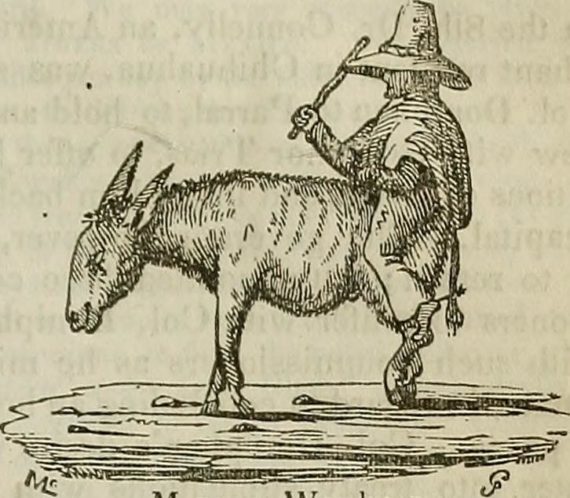A Review of Doniphan’s Expedition, Containing an Account of the Conquest of New Mexico . . . by John T. Hughes. Cincinnati, 1847 and Reid’s Tramp, or a Journal of the Incidents of Ten Months Travel Through Texas, New Mexico, Arizona, Sonora, and California by John Coleman Reid. Selma, Ala., 1858.
The Mexican War and its aftermath turned American attention to the Southwest—an immense, sparsely settled, unmapped, and unknown territory of plains, deserts, mountains, dangerous savages and alien Mexicans. Two antebellum Southerners wrote first-hand books about this region that sold well and were nationally popular.
John Taylor Hughes (1817-1862) was born in Kentucky and was a schoolteacher in Missouri when he enlisted in the 1st Missouri (Mounted) Volunteer Regiment at the beginning of the Mexican War.
Hughes served as a junior officer in the Mexican War Southwestern “expedition” of the 1st Missouri. He considered that campaign, with its discoveries, hardships, and victories, to be a world class epic and its commander Alexander W. Doniphan to be a world class hero.
The full subtitle of Doniphan’s Expedition is . . .Containing an Account of the Conquest of New Mexico; General Kearney’s Overland Expedition to California; Doniphan’s Campaign Against the Navajos; His Unparalleled March Upon Chihuahua and Durango; and the Operation of General Price at Santa Fe; With a Sketch of the Life of Col. Doniphan.
The campaign lasted from June 1846 to August 1847 and was a journey of 3,600 miles. At times the 1st Missouri cooperated with the 2nd Missouri under Sterling Price, which had a similar epic career in the Southwest during the war with Mexico.
The journey was made largely through uncharted territory with no maps and routes identified only by word of mouth of previous travelers. Imagine the need for water and food of a column of 800 or so men and horses, with mule-drawn wagons and two pieces of artillery, in an arid country of killing heat. Water was a necessity for men and beasts and cooking (never mind washing up) as were wagons to carry the water, food, ammunition, horse equipment, and other necessities not to be found in a barren land.
The next source of water might be 60 miles further on, supposing you could find it with word-of-mouth directions and it had not dried up. These men were all volunteers, not clueless 18-year-old conscripts. They endured hunger, thirst, grueling marches, and combat. Many never saw Missouri again but filled lonely desert graves.
After the publication of his book, Hughes settled in Plattsburg, Missouri, where he became a successful planter, newspaper editor, school superintendent, militia colonel, and member of the State legislature. In 1861 he joined Sterling Price in the Missouri State Guard and served on the Confederate side in all of the early battles in Missouri as a colonel and sometimes, as at Elkhorn Tavern (Pea Ridge), as a brigade commander. He was killed in action leading a charge in the Confederate victory at the Battle of Independence on 11 August 1862.
John Coleman Reid (1824—1896), was a born into an Alabama planter family and was a lawyer at Marion. After one term in the State legislature, he declared he was disgusted with politics and in 1857 organised an expedition of adventurers to explore the newly acquired Gadsden Purchase (southern New Mexico and Arizona). The intent was to make this region and its potential for settlement and development examined and made known to Americans.
Reid was elected 1st Lieutenant of a loosely organized “tramp” that left Marion in September 1857 and reached San Francisco months later.
Reid is a colorful writer who recounts interesting adventures. He was also a careful observer of the potential of the territory he crossed. Agriculture was not too promising except in river bottoms which were subject to flooding and sometimes dried up. However, there were many Mexican crops, particularly fruits, flourishing that were not grown in the U.S. There were also deposits of precious metals and minerals. These would require sizable investment in machinery to make them worthwhile.
During the War for Southern Independence, Reid was Colonel of the hard fighting 28th Alabama Regiment, which he had raised, in most of the major battles of the Army of Tennessee. At times he exercised brigade command and was referred to as “general.” After the War he became a prominent attorney at Selma.
Both writers were strong patriots of the republican America that they knew, explaining why both ultimately served in the Confederate army.







